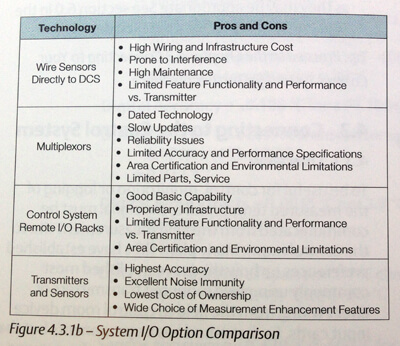Temperature Instrumentation and Systems Controlling
Date:2016-1-29
As technology advances, process automation professionals face a myriad of ways to connect instrumentation and final control elements to their control systems. Some ways include direct wiring, remote I/O, multiplexors, locally mounted transmitters, HART-enabled transmitters, Foundation fieldbus, and IEC 62591 WirelessHART.
When it comes to direct wiring, some instrumentation, such as temperature measurement devices, have special requirements. RTDs use 4-wire copper cables and thermocouples (T/Cs) must use T/C extension cable matched to the sensor type. Low-level sensor signals are highly susceptible to electrical noise from radio frequency interference (RFI), electromagnetic inference (EMI), & electrostatic discharge (ESD). Long sensor leads act like an antenna for this noise resulting in measurement error.
Traditionally, the signal conditioning to convert these temperature sensor low-level signals to high-level signals is done in the control system I/O cards. With remote I/O, these control system I/O cards are mounted closer to the sensors to minimize the cable distance and reduce the opportunity for RFI/EMI/ESD disturbances.
With longstanding multiplexor technology, the sensor signals are gathered and communicated with the control system using either a serial transmission (RS232C or RS485) or Ethernet-based transmission. These communications may use a proprietary protocol provided by the control system manufacturer or one of the other standard protocols such as MODBUS, OPC, or Profibus.
A temperature transmitter is when the signal conditioning is done at the sensor, typically mounted in a connection head or enclosure mounted integrally with the sensor and thermowell. Or, the signal conditioner is sometimes remotely mounted nearby to the sensor. The most popular temperature transmitters are HART-based and they offer a wide array of diagnostics and functions that deliver an accurate and reliable measurement signal under even the most adverse environmental and/or electrically noisy conditions.
Transmitters can communicate their information to a control system using an analog (4-20ma) signal or digital protocols including HART, Foundation fieldbus, Profibus, and IEC 62591 WirelessHART, all providing highly reliable methods of communicating temperature measurements.
 Each method of connection between the field devices and control system has its respective pros and cons as is summarized in the table.
Each method of connection between the field devices and control system has its respective pros and cons as is summarized in the table.
When it comes to direct wiring, some instrumentation, such as temperature measurement devices, have special requirements. RTDs use 4-wire copper cables and thermocouples (T/Cs) must use T/C extension cable matched to the sensor type. Low-level sensor signals are highly susceptible to electrical noise from radio frequency interference (RFI), electromagnetic inference (EMI), & electrostatic discharge (ESD). Long sensor leads act like an antenna for this noise resulting in measurement error.
Traditionally, the signal conditioning to convert these temperature sensor low-level signals to high-level signals is done in the control system I/O cards. With remote I/O, these control system I/O cards are mounted closer to the sensors to minimize the cable distance and reduce the opportunity for RFI/EMI/ESD disturbances.
With longstanding multiplexor technology, the sensor signals are gathered and communicated with the control system using either a serial transmission (RS232C or RS485) or Ethernet-based transmission. These communications may use a proprietary protocol provided by the control system manufacturer or one of the other standard protocols such as MODBUS, OPC, or Profibus.
A temperature transmitter is when the signal conditioning is done at the sensor, typically mounted in a connection head or enclosure mounted integrally with the sensor and thermowell. Or, the signal conditioner is sometimes remotely mounted nearby to the sensor. The most popular temperature transmitters are HART-based and they offer a wide array of diagnostics and functions that deliver an accurate and reliable measurement signal under even the most adverse environmental and/or electrically noisy conditions.
Transmitters can communicate their information to a control system using an analog (4-20ma) signal or digital protocols including HART, Foundation fieldbus, Profibus, and IEC 62591 WirelessHART, all providing highly reliable methods of communicating temperature measurements.

- Pre:How to Install a Flowmeter - Best Installation Practices 2016/1/30
- Next:India Exhibition-2013 2013/8/9
